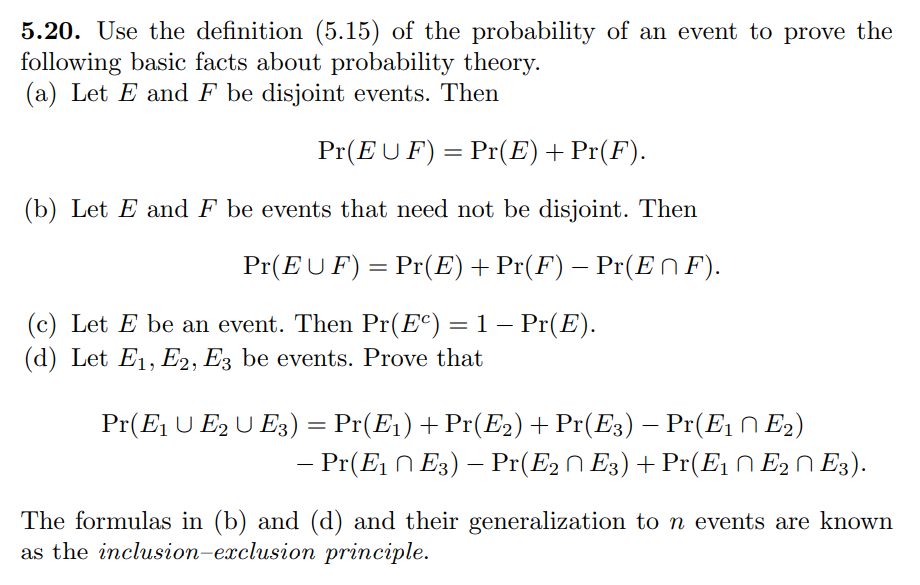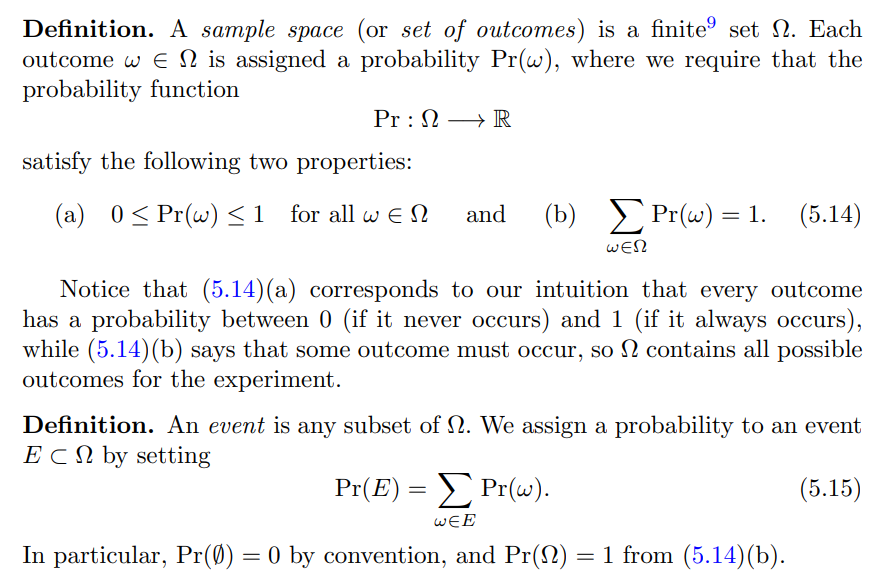5.20. Use the definition (5.15) of the probability of an event to prove the following basic facts about probability theory. (a) Let E and F be disjoint events. Then Pr(EU F) = Pr(E) + Pr(F). (b) Let E and F be events that need not be disjoint. Then Pr(EU F) = Pr(E) + Pr(F) − Pr(E^ F). (c) Let E be an event. Then Pr(Ec) = 1 − Pr(E). (d) Let E1, E2, E3 be events. Prove that Pr(E₁ ¯ E2 ¯ E3) = Pr(E₁) + Pr(E2) + Pr(E3) − Pr(E₁ ^ E₂) – Pr(E₁ ^ E3) — Pr(E2 ^ E3) + Pr(E₁ ^ E2 ^ E3). The formulas in (b) and (d) and their generalization to n events are known as the inclusion-exclusion principle.
5.20. Use the definition (5.15) of the probability of an event to prove the following basic facts about probability theory. (a) Let E and F be disjoint events. Then Pr(EU F) = Pr(E) + Pr(F). (b) Let E and F be events that need not be disjoint. Then Pr(EU F) = Pr(E) + Pr(F) − Pr(E^ F). (c) Let E be an event. Then Pr(Ec) = 1 − Pr(E). (d) Let E1, E2, E3 be events. Prove that Pr(E₁ ¯ E2 ¯ E3) = Pr(E₁) + Pr(E2) + Pr(E3) − Pr(E₁ ^ E₂) – Pr(E₁ ^ E3) — Pr(E2 ^ E3) + Pr(E₁ ^ E2 ^ E3). The formulas in (b) and (d) and their generalization to n events are known as the inclusion-exclusion principle.
Algebra and Trigonometry (MindTap Course List)
4th Edition
ISBN:9781305071742
Author:James Stewart, Lothar Redlin, Saleem Watson
Publisher:James Stewart, Lothar Redlin, Saleem Watson
Chapter14: Counting And Probability
Section14.2: Probability
Problem 3E: The conditional probability of E given that F occurs is P(EF)=___________. So in rolling a die the...
Related questions
Question
[Algebraic Cryptography] How do you solve this? The second picture is definitions

Transcribed Image Text:5.20. Use the definition (5.15) of the probability of an event to prove the
following basic facts about probability theory.
(a) Let E and F be disjoint events. Then
Pr(EU F) = Pr(E) + Pr(F).
(b) Let E and F be events that need not be disjoint. Then
Pr(EUF) = Pr(E) + Pr(F) − Pr(E^F).
(c) Let E be an event. Then Pr(Ec) = 1 − Pr(E).
(d) Let E1, E2, E3 be events. Prove that
Pr(E₁ U E2 U E3) = Pr(E₁) + Pr(E2) + Pr(E3) — Pr(E₁ ^ E₂)
– Pr(E₁ E3) — Pr(E2 ~ E3) + Pr(E₁ E₂ E3).
The formulas in (b) and (d) and their generalization to n events are known
as the inclusion-exclusion principle.

Transcribed Image Text:Definition. A sample space (or set of outcomes) is a finite⁹ set . Each
outcome we is assigned a probability Pr(w), where we require that the
probability function
Pr : Ω
satisfy the following two properties:
(a) 0≤ Pr(w) ≤ 1 for all w EN and (b) Σ Pr(ω) = 1. (5.14)
WEN
R
Notice that (5.14) (a) corresponds to our intuition that every outcome
has a probability between 0 (if it never occurs) and 1 (if it always occurs),
while (5.14) (b) says that some outcome must occur, so contains all possible
outcomes for the experiment.
Definition. An event is any subset of 2. We assign a probability to an event
ECN by setting
(5.15)
Pr(E) = Σ Pr(w).
WEE
In particular, Pr(Ø) = 0 by convention, and Pr(N) = 1 from (5.14)(b).
Expert Solution
This question has been solved!
Explore an expertly crafted, step-by-step solution for a thorough understanding of key concepts.
Step by step
Solved in 2 steps with 1 images

Recommended textbooks for you

Algebra and Trigonometry (MindTap Course List)
Algebra
ISBN:
9781305071742
Author:
James Stewart, Lothar Redlin, Saleem Watson
Publisher:
Cengage Learning

College Algebra
Algebra
ISBN:
9781305115545
Author:
James Stewart, Lothar Redlin, Saleem Watson
Publisher:
Cengage Learning

Algebra & Trigonometry with Analytic Geometry
Algebra
ISBN:
9781133382119
Author:
Swokowski
Publisher:
Cengage

Algebra and Trigonometry (MindTap Course List)
Algebra
ISBN:
9781305071742
Author:
James Stewart, Lothar Redlin, Saleem Watson
Publisher:
Cengage Learning

College Algebra
Algebra
ISBN:
9781305115545
Author:
James Stewart, Lothar Redlin, Saleem Watson
Publisher:
Cengage Learning

Algebra & Trigonometry with Analytic Geometry
Algebra
ISBN:
9781133382119
Author:
Swokowski
Publisher:
Cengage
